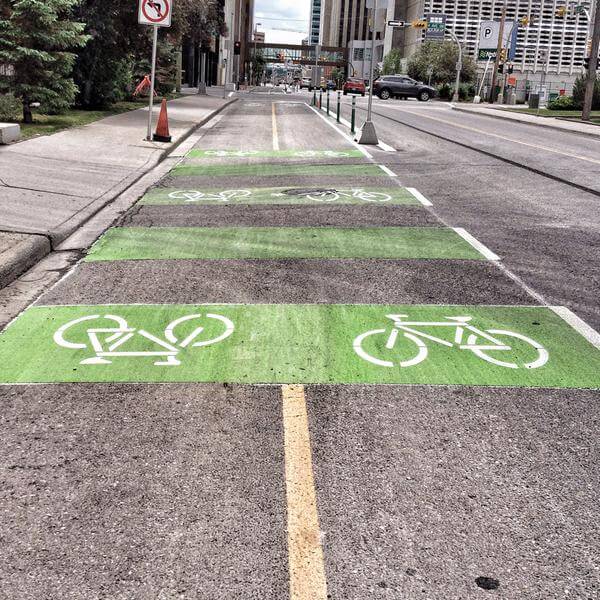Autumn Gear Guide
Find inspiration in our Gear Guide that will keep you out on your bike through wind or rain.
Download NowSeparated cycling infrastructure projects yield impressive results for transportation cash strapped cities.

“My face hurts from smiling. Calgary cycle track rocks.” via @danmiller509
For summer 2015, Calgary, AB, intended to launch a pilot network of cycle tracks (aka protected bike lanes) on four downtown streets, all at once. While most cities are taking a piecemeal approach to cycling infrastructure, upgrading streets one at a time, the plan seemed ambitious for North American transportation project standards. The results: installation was completed two weeks ahead of schedule and $1.35 million CAD under budget.
When it comes to transportation projects, being over budget and significantly behind schedule often feels like the norm. Highway, transit, and bridge projects are often complex and budget overages and installation delays are understandable, if no less frustrating. However, as North Americans are quickly learning, when it comes to cycling infrastructure you can expect much more for significantly less.
In Toronto, ON, a pilot project also saw cycle tracks installed on part of several downtown major streets in 2014. While a far cry from anything representing a true network (what Gil Penalosa refers to as a Minimum Grid), the early results in Toronto are what planners everywhere are learning to expect from protected cycling infrastructure. One one street in the pilot project the number of daily cycling trips tripled, on the other two they doubled. Drivers felt no inconvenience from the lanes with travel times remaining steady.
These impressive numbers, in Toronto revealing that you can increase capacity on a street by separating space for people on bikes, are also winning over critics. While still considered to be “baby steps” toward an actual network, expansion of the existing lanes was approved by the city’s public works committee to be presented to city council later this summer.
The seemingly inherent benefits of separating cycling space are hard to ignore and are finding mainstream appeal. A recent article in the Washington Post by Matt McFarland touted protected bike lanes as “the next great American transit project” to be undertaken. As McFarland discovered:
The National Institute for Transportation and Communities looked at bike traffic on nine U.S. roads after cycletracks were added. Across the board bike traffic grew, ranging from 21 to 171 percent. This jibes with research showing that cyclists say they are motivated to ride when routes are buffered from traffic noise and pollution, and paths separated from traffic.
But, according to McFarland, one final hurdle stands in the way:
It’s difficult to estimate what a national installment of cycletracks in U.S. cities would cost. But the cost would certainly pale in comparison to typical transportation projects. Bike infrastructure can range from $100,000 per mile to a few million. For example, Austin estimated a 200-mile network of on-street bike facilities would cost $290,000 per mile. Building 47 miles of urban trails would cost it $2 million per mile.
But first we’ll need a sincere commitment to building safe bike infrastructure, so that all Americans feel comfortable riding.
Find inspiration in our Gear Guide that will keep you out on your bike through wind or rain.
Download Now
The pilot is only for 1 year in Calgary which is not enough time to build up cycling mode share. It takes time (several months), for people /wannabes to warm up to cycle several times per wk. and become familiar with choice cycle tracks for their local rides.
Unbelievable there are some local critics (and I’ve met them in person. They live in my neighbourhood where the cycle tracks are located), who don’t even trust the automatic computer Eco-counter in pavement wired counting system. And some of the these people are college/university educated.
Comments are closed.